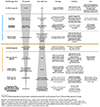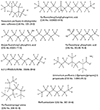Strategies for grouping per- and polyfluoroalkyl substances (PFAS) to protect human and environmental health
- PMID: 32495786
- PMCID: PMC7585739
- DOI: 10.1039/d0em00147c
Strategies for grouping per- and polyfluoroalkyl substances (PFAS) to protect human and environmental health
Abstract
Grouping strategies are needed for per- and polyfluoroalkyl substances (PFAS), in part, because it would be time and resource intensive to test and evaluate the more than 4700 PFAS on the global market on a chemical-by-chemical basis. In this paper we review various grouping strategies that could be used to inform actions on these chemicals and outline the motivations, advantages and disadvantages for each. Grouping strategies are subdivided into (1) those based on the intrinsic properties of the PFAS (e.g. persistence, bioaccumulation potential, toxicity, mobility, molecular size) and (2) those that inform risk assessment through estimation of cumulative exposure and/or effects. The most precautionary grouping approach of those reviewed within this article suggests phasing out PFAS based on their high persistence alone (the so-called "P-sufficient" approach). The least precautionary grouping approach reviewed advocates only grouping PFAS for risk assessment that have the same toxicological effects, modes and mechanisms of action, and elimination kinetics, which would need to be well documented across different PFAS. It is recognised that, given jurisdictional differences in chemical assessment philosophies and methodologies, no one strategy will be generally acceptable. The guiding question we apply to the reviewed grouping strategies is: grouping for what purpose? The motivation behind the grouping (e.g. determining use in products vs. setting guideline levels for contaminated environments) may lead to different grouping decisions. This assessment provides the necessary context for grouping strategies such that they can be adopted as they are, or built on further, to protect human and environmental health from potential PFAS-related effects.
Conflict of interest statement
Conflicts of Interest
This paper does not necessarily reflect the opinions or the policies of the German Environment Agency. Ian Cousins has provided expert reports in three separate class actions related to PFAS in the Federal Court of Australia. Jamie DeWitt is serving as a plaintiff’s expert witness in several cases related to PFAS. No other authors declare any conflicts of interest.
Figures



References
-
- OECD/UNEP, Toward a new comprehensive global database of per- and polyfluoroalkyl substances (PFASs): Summary report on updating the OECD 2007 list of per- and polyfluoroalkyl substances (PFASs), Organisation for Economic Co-operation and Development; 2018.
-
- Wang ZY; DeWitt JC; Higgins CP; Cousins IT, A Never-Ending Story of Per- and Polyfluoroalkyl Substances (PFASs)? Environ. Sci. Technol 2017, 51, (5), 2508–2518. - PubMed
-
- Wang ZY; Cousins IT; Scheringer M; Hungerbuehler K, Hazard assessment of fluorinated alternatives to long-chain perfluoroalkyl acids (PFAAs) and their precursors: Status quo, ongoing challenges and possible solutions. Environ. Int 2015, 75, 172–179. - PubMed
-
- Scheringer M; Trier X; Cousins IT; de Voogt P; Fletcher T; Wang ZY; Webster TF, Helsingor Statement on poly- and perfluorinated alkyl substances (PFASs). Chemosphere 2014, 114, 337–339. - PubMed
MeSH terms
Substances
Grants and funding
LinkOut - more resources
Full Text Sources
Medical

